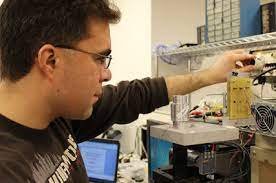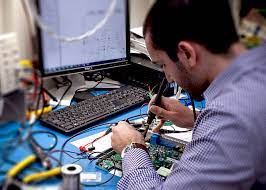Free Hardware Engineer Course (1year Diploma Course)
Hardware Engineer in the IT-ITeS Industry is also known as a Component Engineer, Design Engineer, Layout Engineers, Component Design Engineers, Analog Design Engineers
Brief Job Description: -Professionals in this role are responsible for design, development and testing of product hardware, including computer systems, and circuit boards
Personal Attributes:- This job requires the individual to work collaboratively with diverse teams. The individual should be able to hold interest in technology changes; demonstrate strong technical expertise and possess good oral and written communications skills. The individual should also be comfortable working with deadlines and budgets Hardware Engineer Course.


Design electronic circuits Hardware Engineer Course:-
To be competent, you must be able to:
PC1. establish your role and responsibilities in designing electronic circuits
PC2. establish design requirements and constraints
PC3. identify any issues with design requirements or constraints and clarify these with appropriate people
PC4. access reusable components, relevant best practices and design standards from your organization’s knowledge base
PC5. use standard tools to simulate, analyze and synthesize design options for electronic circuits
PC6. select design options that comply with design requirements and constraints Hardware Engineer Course.
PC7. review design options with appropriate people and =incorporate their inputs
PC8. document designs using standard templates and tools
PC9. update your organization’s knowledge base with new designs
PC10. obtain advice and guidance on designing electronic circuits from appropriate people, where required
PC11. comply with your organization’s policies, procedures and guidelines when designing electronic circuits
PC12. understand the firmware, load and use it


Design electronic logic Hardware Engineer Course:- To be competent, you must be able to:
PC1. establish your role and responsibilities in designing electronic logic Hardware Engineer Course.
PC2. establish design requirements and constraints
PC3. identify any issues with design requirements or constraints and clarify these with appropriate people
PC4. access reusable components, relevant best practices and design standards from your organization’s knowledge base
PC5. use standard tools to simulate, analyze and synthesize design options for electronic logic
PC6. select design options that comply with design requirements and constraints
PC7. review design options with appropriate people and incorporate their inputs
PC8. document designs using standard templates and tools
PC9. update your organization’s knowledge base with new designs
PC10. obtain advice and guidance on designing electronic logic from appropriate people, where required
PC11. comply with your organization’s policies, procedures and guidelines when designing electronic logic
Design firmware:- To be competent, you must be able to:
PC1. establish your role and responsibilities in designing firmware Hardware Engineer Course.
PC2. establish firmware requirements and constraints
PC3. identify any issues with firmware requirements or constraints and clarify these with appropriate people
PC4. access reusable components, relevant best practices and design standards from your organization’s knowledge base
PC5. create design options that comply with firmware requirements and constraints
PC6. review design options with appropriate people and incorporate their inputs
PC7. document designs using standard templates and tools
PC8. update your organization’s knowledge base with new designs
PC9. obtain advice and guidance on designing firmware from appropriate people, where required
PC10. comply with your organization’s policies, procedures and guidelines when designing firmware


Design printed circuit boards (PCBs) Hardware Engineer Course:- To be competent, you must be able to:
PC1. establish your role and responsibilities in designing PCBs
PC2. establish design requirements and constraints Hardware Engineer Course.
PC3. identify any issues with design requirements or constraints and clarify these with appropriate people
PC4. access reusable components, relevant best practices and design standards from your organization’s knowledge base
PC5. use standard tools to simulate, analyze and synthesize design options for PCBs
PC6. select design options that comply with design requirements and constraints
PC7. review design options with appropriate people and incorporate their inputs
PC8. document designs using standard templates and tools
PC9. update your organization’s knowledge base with new designs
PC10. obtain advice and guidance on designing PCBs from appropriate people, where required
PC11. comply with your organization’s policies, procedures and guidelines when designing PCBs
Validate electronic designs Hardware Engineer Course:-
To be competent, you must be able to:
PC1. establish clearly your role and responsibilities within Design Validation Testing (DVT) plans
PC2. identify any issues in DVT plans and clarify these with appropriate people
PC3. carry out tests as per DVT plans using standard validation tools and probes Hardware Engineer Course.
PC4. record testing processes and results accurately using standard tools and templates
PC5. analyze test results, where you are competent and required to do so
PC6. present test results clearly to appropriate people, using standard tools and templates
PC7. obtain feedback from appropriate people to finalize designs
PC8. communicate test results and required changes clearly to the design team
PC9. obtain advice and guidance on validating electronic designs from appropriate people, where required
PC10. comply with your organization’s policies, standards, procedures and guidelines when validating electronic designs
Create documents for knowledge sharing Hardware Engineer Course:- To be competent, you must be able to:
PC1. establish with appropriate people the purpose, scope, formats and target audience for the documents
PC2. access existing documents, language standards, templates and documentation tools from your organization’s knowledge base
PC3. liaise with appropriate people to obtain and verify the information required for the documents PC4. confirm the content and structure of the documents with appropriate people
PC5. create documents using standard templates and agreed language standards Hardware Engineer Course.
PC6. review documents with appropriate people and incorporate their inputs
PC7. submit documents for approval by appropriate people
PC8. publish documents in agreed formats
PC9. update your organization’s knowledge base with the documents
PC10. comply with your organization’s policies, procedures and guidelines when creating documents for knowledge sharing
Manage your work to meet requirements:- To be competent on the job, you must be able to:
PC1. establish and agree your work requirements with appropriate people
PC2. keep your immediate work area clean and tidy
PC3. utilize your time effectively
PC4. use resources correctly and efficiently
PC5. treat confidential information correctly
PC6. work in line with your organization’s policies and procedures
PC7. work within the limits of your job role
PC8. obtain guidance from appropriate people, where necessary Hardware Engineer Course.
PC9. ensure your work meets the agreed requirements
Work effectively with colleagues:-
To be competent, you must be able to:
PC1. communicate with colleagues clearly, concisely and accurately
PC2. work with colleagues to integrate your work effectively with them
PC3. pass on essential information to colleagues in line with organizational requirements
PC4. work in ways that show respect for colleagues
PC5. carry out commitments you have made to colleagues
PC6. let colleagues know in good time if you cannot carry out your commitments, explaining the reasons
PC7. identify any problems you have working with colleagues and take the initiative to solve these problems
PC8. follow the organization’s policies and procedures for working with colleagues
Provide data/information in standard formats:- To be competent, you must be able to:
PC1. establish and agree with appropriate people the data/information you need to provide, the formats in which you need to provide it, and when you need to provide it
PC2. obtain the data/information from reliable sources
PC3. check that the data/information is accurate, complete and up-to-date Hardware Engineer Course.
PC4. obtain advice or guidance from appropriate people where there are problems with the data/information
PC5. carry out rule-based analysis of the data/information, if required PC6. insert the data/information into the agreed formats
PC7. check the accuracy of your work, involving colleagues where required
PC8. report any unresolved anomalies in the data/information to appropriate people
PC9. provide complete, accurate and up-to-date data/information to the appropriate people in the required formats on time
Develop your knowledge, skills and competence:- To be competent, you must be able to:
PC1. obtain advice and guidance from appropriate people to develop your knowledge, skills and competence
PC2. identify accurately the knowledge and skills you need for your job role
PC3. identify accurately your current level of knowledge, skills and competence and any learning and development needs
PC4. agree with appropriate people a plan of learning and development activities to address your learning needs
PC5. undertake learning and development activities in line with your plan
PC6. apply your new knowledge and skills in the workplace, under supervision
PC7. obtain feedback from appropriate people on your knowledge and skills and how effectively you apply them
PC8. review your knowledge, skills and competence regularly and take appropriate Hardware Engineer Course.
Guidelines for Assessment:

- Criteria for assessment for each Qualification Pack (QP) will be created by the Sector Skill Council (SSC). Each performance criteria (PC) will be assigned Theory and Skill/Practical marks proportional to its importance in
NOS. 2. The assessment will be conducted online through assessment providers authorised by
SSC. 3. Format of questions will include a variety of styles suitable to the PC being tested such as multiple choice questions, fill in the blanks, situational judgment test, simulation and programming test.
4. To pass a QP, a trainee should pass each individual NOS. Standard passing criteria for each NOS is 70%. 5. For latest details on the assessment criteria,
(Design electronic circuits):- PC1. establish your role and responsibilities in designing electronic circuits
PC2. establish design requirements and constraints
PC3. identify any issues with design requirements or constraints and clarify these with appropriate people
PC4. access reusable components, relevant best practices and design standards from your organization’s knowledge base
PC5. use standard tools to simulate, analyze and synthesize design options for electronic circuits
PC6. select design options that comply with design requirements and constraints
PC7. review design options with appropriate people and =incorporate their inputs
PC8. document designs using standard templates and tools
PC9. update your organization’s knowledge base with new designs
PC10. obtain advice and guidance on designing electronic circuits from appropriate people, where required
PC11. comply with your organization’s policies, procedures and guidelines when designing electronic circuits
PC12. understand the firmware, load and use it
(Design electronic logic):- PC1. establish your role and responsibilities in designing electronic logic
PC2. establish design requirements and constraints
PC3. identify any issues with design requirements or constraints and clarify these with appropriate people
PC4. access reusable components, relevant best practices and design standards from your organization’s knowledge base
PC5. use standard tools to simulate, analyze and synthesize design options for electronic logic
PC6. select design options that comply with design requirements and constraints
PC7. review design options with appropriate people and incorporate their inputs
PC8. document designs using standard templates and tools
PC9. update your organization’s knowledge base with new designs
PC10. obtain advice and guidance on designing electronic logic from appropriate people, where required
PC11. comply with your organization’s policies, procedures and guidelines when designing electronic logic
(Design firmware):-
PC1. establish your role and responsibilities in designing firmware
PC2. establish firmware requirements and constraints
PC3. identify any issues with firmware requirements or constraints and clarify these with appropriate people
PC4. access reusable components, relevant best practices and design standards from your organization’s knowledge base
PC5. create design options that comply with firmware requirements and constraints
PC6. review design options with appropriate people and incorporate their inputs
PC7. document designs using standardtemplates and tools
PC8. update your organization’s knowledge base with new designs
PC9. obtain advice and guidance on designing firmware from appropriate people, where required
PC10. comply with your organization’s policies, procedures and guidelines when designing firmware

(Design printed circuits boards (PCB)):-
PC1. establish your role and responsibilities in designing PCBs
PC2. establish design requirements and constraints
PC3. identify any issues with design requirements or constraints and clarify these with appropriate people
PC4. access reusable components, relevant best practices and design standards from your organization’s knowledge base
PC5. use standard tools to simulate, analyze and synthesize design options for PCBs
PC6. select design options that comply with design requirements and constraints
PC7. review design options with appropriate people and incorporate their inputs
PC8. document designs using standard templates and tools
PC9. update your organization’s knowledge base with new designs
PC10. obtain advice and guidance on designing PCBs from appropriate people, where required
PC11. comply with your organization’s policies, procedures and guidelines when designing PCBs
(Validate electronic designs):- PC1. establish clearly your role and responsibilities within Design Validation Testing (DVT) plans
PC2. identify any issues in DVT plans and clarify these with appropriate people
PC3. carry out tests as per DVT plans using standard validation tools and probes
PC4. record testing processes and results accurately using standard tools and templates
PC5. analyze test results, where you are competent and required to do so
PC6. present test results clearly toappropriate people, using standard tools and templates
PC7. obtain feedback from appropriate people to finalize designs
PC8. communicate test results and required changes clearly to the design team
PC9. obtain advice and guidance on validating electronic designs from appropriate people, where required
PC10. comply with your organization’s policies, standards, procedures and guidelines when validating electronic designs
(Create documents for knowledge sharing):-
PC1. establish with appropriate people the purpose, scope, formats and target audience for the documents
PC2. access existing documents, language standards, templates and documentation tools from your organization’s knowledge base
PC3. liaise with appropriate people to obtain and verify the information required for the documents
PC4. confirm the content and structure of the documents with appropriate people
PC5. create documents using standard templates and agreed language standard
PC6. review documents with appropriate people and incorporate their inputs
PC7. submit documents for approval by appropriate people
PC8. publish documents in agreed formats
PC9. update your organization’s knowledge base with the documents
PC10. comply with your organization’s policies, procedures and guidelines when creating documents for knowledge sharing

(Manage your work to meet requirements):-
PC1. establish and agree your work requirements with appropriate people
PC2. keep your immediate work area clean and tidy
PC3. utilize your time effectively
PC4. use resources correctly and efficiently
PC5. treat confidential information correctly
PC6. work in line with your organization’s policies and procedures
PC7. work within the limits of your job role
PC8. obtain guidance from appropriate people, where necessary
PC9. ensure your work meets the agreed requirements
(Work effectively with colleagues):-
PC1. communicate with colleagues clearly, concisely and accurately
PC2. work with colleagues to integrate your work effectively with theirs
PC3. pass on essential information to colleagues in line with organizational requirements
PC4. work in ways that show respect for colleagues
PC5. carry out commitments you have made to colleagues
PC6. let colleagues know in good time if you cannot carry out your commitments, explaining the reasons
PC7. identify any problems you have working with colleagues and take the initiative to solve these problems
PC8. follow the organization’s policies and procedures for working with colleagues
(Maintain a healthy, safe and secure working environment):-
PC1. comply with your organization’s current health, safety and security policies and procedures
PC2. report any identified breaches in health, safety, and security policies and procedures to the designated person
PC3. identify and correct any hazards that you can deal with safely, competently and within the limits of your authority
PC4. report any hazards that you are not competent to deal with to the relevant person in line with organizational procedures and warn other people who may be affected
PC5. follow your organization’s emergency procedures promptly, calmly, and efficiently
PC6. identify and recommend opportunities for improving health, safety, and security to the designated person
PC7. complete any health and safety records legibly and accurately
(Provide data/information in standard formats):-
PC1. establish and agree with appropriate people the data/information you need to provide, the formats in which you need to provide it, and when you need to provide it
PC2. obtain the data/information from reliable sources
PC3. check that the data/information is accurate, complete and up-to-date
PC4. obtain advice or guidance from appropriate people where there are problems with the data/information
PC5. carry out rule-based analysis of the data/information, if required
PC6. insert the data/information into the agreed formats
PC7. check the accuracy of your work, involving colleagues where required
PC8. report any unresolved anomalies in the data/information to appropriate people
PC9. provide complete, accurate and up-to-date data/information to the appropriate people in the required formats on time
(Develop your knowledge, skills and competence):-
PC1. obtain advice and guidance from appropriate people to develop your knowledge, skills and competence
PC2. identify accurately the knowledge and skills you need for your job role
PC3. identify accurately your current level of knowledge, skills and competence and any learning and development needs
PC4. agree with appropriate people a plan of learning and development activities to address your learning needs
PC5. undertake learning and development activities in line with your plan
PC6. apply your new knowledge and skills in the workplace, under supervision
PC7. obtain feedback from appropriate people on your knowledge and skills and how effectively you apply them
PC8. review your knowledge, skills and competence regularly and take appropriate action
Organizational Context (Knowledge of the company/ organization and its processes):-
You need to know and understand:
KA1. your organization’s procedures and guidelines for developing your knowledge, skills and competence and your role and responsibilities in relation to this
KA2. the importance of developing your knowledge, skills and competence to you and your organization
KA3. different methods used by your organization to review skills and knowledge including: training
· need analysis
· skills need analysis
· performance appraisals
KA4. how to review your knowledge and skills against your job role using different methods and analysis
KA5. different types of learning and development activities available for your job role and how to access these
KA6. how to produce a plan to address your learning and development needs, who to agree it with and the importance of undertaking the planned activities
KA7. different types of support available to help you plan and undertake learning and development activities and how to access these
KA8. why it is important to maintain records of your learning and development

KA9. methods of obtaining and accepting feedback from appropriate people on your knowledge skills and competence
KA10. how to use feedback to develop in your job role
Technical Knowledge:- You need to know and understand:
KB1. the knowledge and skills required in your job role
KB2. your current learning and development needs in relation to your job role
KB3. different types of learning styles and methods including those that help you learn best
KB4. the importance of taking responsibility for your own learning and development
KB5. to the importance of learning and practicing new concepts, theory and how to apply these in the work environment or on samples.
KB6. how to explore sample problems and apply solutions
Core Skills/ Generic Skills:-
You need to know and understand how to:
SA1. communicate with colleagues in writing
Reading Skills:-
You need to know and understand how to:
SA2. read instructions, guidelines and procedures
Oral Communication (Listening and Speaking skills):-
You need to know and understand how to:
SB1. make a decision on a suitable course of action
Plan and Organize:-
You need to know and understand how to:
SB2. plan and organize your work to achieve targets and deadlines
Customer Centricity:-
You need to know and understand how to:
SB3. check that your own work meets customer requirements
Problem Solving:- You need to know and understand how to:
SB4. refer anomalies to the line manager
Analytical Thinking:-
You need to know and understand how to:
SB5. analyze data and activities

Critical Thinking:-
You need to know and understand how to:
SB6. apply balanced judgments to different situations
Attention to Detail:-
You need to know and understand how to:
SB7. check your work is complete and free from errors
SB8. get your work checked by peers
Team Working:-
You need to know and understand how to:
SB9. work effectively in a team environment
Technical Skills :-
You need to know and understand how to:
SC1. use information technology effectively
SC2. agree objectives and work requirements
SC3. keep up to date with changes, procedures and practices in your role






